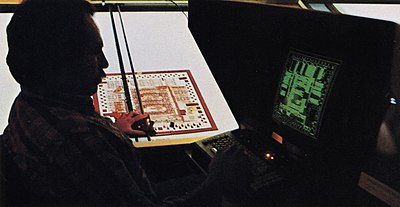
Back Disseny de circuits integrats Catalan Entwurf integrierter Schaltungen German طراحی مدار مجتمع Persian Conception de circuits intégrés French एकीकृत परिपथ की डिजाइन Hindi Desain sirkuit terpadu ID 集積回路設計 Japanese 집적 회로 설계 Korean Конструювання мікросхем Ukrainian 集成电路设计 Chinese
This article includes a list of general references, but it lacks sufficient corresponding inline citations. (March 2019) |


Integrated circuit design, semiconductor design, chip design or IC design, is a sub-field of electronics engineering, encompassing the particular logic and circuit design techniques required to design integrated circuits, or ICs. ICs consist of miniaturized electronic components built into an electrical network on a monolithic semiconductor substrate by photolithography.
IC design can be divided into the broad categories of digital and analog IC design. Digital IC design is to produce components such as microprocessors, FPGAs, memories (RAM, ROM, and flash) and digital ASICs. Digital design focuses on logical correctness, maximizing circuit density, and placing circuits so that clock and timing signals are routed efficiently. Analog IC design also has specializations in power IC design and RF IC design. Analog IC design is used in the design of op-amps, linear regulators, phase locked loops, oscillators and active filters. Analog design is more concerned with the physics of the semiconductor devices such as gain, matching, power dissipation, and resistance. Fidelity of analog signal amplification and filtering is usually critical, and as a result analog ICs use larger area active devices than digital designs and are usually less dense in circuitry.
Modern ICs are enormously complicated. An average desktop computer chip, as of 2015, has over 1 billion transistors. The rules for what can and cannot be manufactured are also extremely complex. Common IC processes of 2015 have more than 500 rules. Furthermore, since the manufacturing process itself is not completely predictable, designers must account for its statistical nature. The complexity of modern IC design, as well as market pressure to produce designs rapidly, has led to the extensive use of automated design tools in the IC design process. The design of some processors has become complicated enough to be difficult to fully test, and this has caused problems at large cloud providers.[1] In short, the design of an IC using EDA software is the design, test, and verification of the instructions that the IC is to carry out. Artificial Intelligence has been demonstrated in chip design for creating chip layouts which are the locations of standard cells and macro blocks in a chip.[2]